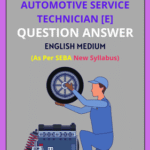Class 10 Automotive Service Technician Chapter 3 Optimize Resource Utilization Solutions English Medium to each chapter is provided in the list so that you can easily browse through different chapters Class 10 Automotive Service Technician Chapter 3 Optimize Resource Utilization Question Answer and select need one. Class 10 Automotive Service Technician Chapter 3 Optimize Resource Utilization Solutions Download PDF. SEBA Class 10 Elective Automotive Service Technician Texbook Solutions English Medium.
Class 10 Automotive Service Technician Chapter 3 Optimize Resource Utilization
Also, you can read the NCERT book online in these sections Solutions by Expert Teachers as per Central Board of Secondary Education (CBSE) Book guidelines. SEBA Class 10 Elective Automotive Service Technician Textual Solutions in English are part of All Subject Solutions. Here we have given SEBA Class 10 Elective Automotive Service Technician Notes, SEBA Class 10 Elective Automotive Service Technician English Medium Textbook Solutions for All Chapters, You can practice these here.
Optimize Resource Utilization
Chapter: 3
Unit 3.1 – Resource Optimization
Unit Objectives: At the end of this unit, participants will be able to:
1. List the ways to optimize usage of resources.
Ans: To optimize the usage of resources:
(i) Employ ways for efficient utilization of material and water.
(ii) Use energy efficient electrical appliances and devices to ensure energy conservation.
(iii) Implement energy management programs and systems.
(iv) Conduct regular feedbacks and introduce incentive programs to motivate energy-saving behavior.
(v) Take steps like switching off devices when not in use to save energy.
(vi) Optimize HVAC systems by adjusting temperatures during non-operating days.
(vii) Reduce air-conditioning by planting trees to cool buildings.
(viii) Carry out maintenance and control checks on machinery and painting lines.
2. Employ ways for efficient utilization of material and water.
Ans: In today’s world, the automotive industry continuously explores energy efficiency options. The company aims to reduce production costs while maintaining product quality and passenger safety.
Resource optimization includes:
(i) Employ ways for efficient utilization of material and water.
(ii) Reuse and recycle water; install water-saving equipment.
(iii) Prevent leaks in equipment, compressors, and pipes.
(iv) Retrofit existing equipment to minimize water and energy usage.
(v) Carry out maintenance and control checks on machinery and painting lines.
3. Use energy efficient electrical appliances and devices to ensure energy conservation.
Ans: To ensure energy conservation in the automotive industry, it is essential to:
(i) Use energy efficient electrical appliances and devices.
(ii) Install energy-efficient lighting (like CFLs or LEDs).
(iii) Upgrade outdated equipment with energy-efficient alternatives.
(iv) Take steps like switching off devices when not in use.
(v) Optimize HVAC systems by adjusting temperatures during non-operating days.
(vi) Power down the equipment when not in use.
(vii) Implement energy management programs and systems.
| Unit 3.2 – Waste Management |
Unit Objectives: At the end of this unit, participants will be able to:
1. Discuss various methods of waste management and its disposal.
Ans: Waste management is gathering, transport, recycling, processing and disposal of waste materials. Waste management is carried by recovering resources from waste materials. It involves waste substances (i.e. gaseous, solid, liquid or radioactive), expert personnel and different methods of management.
Methods of Waste Management:
(i) Segregation: Waste separation using container units is necessary because plastics, building materials, glass, and site waste take a long time to decompose. It supports removal of hazardous waste from compostable, non-hazardous solid waste, organic waste, recyclable materials, etc.
(ii) Composting: This waste management process turns waste into organic compounds that you can use to feed plants. In terms of the environment advantages this is actually beneficial technique. Making use of this method, it’s easy to turn unsafe organic products into safe compost.
(iii) Landfill: A commonly used method that buries waste. Only non-recyclable or non-compostable waste should be sent to landfills after sorting. Odour and danger are eliminated before dumping.
(iv) Recycling: Products like PVC, LDEP, PP and PS are recyclable though they are not collected for recycling. The material, which is composed of a single type, is recyclables and is much easy to work with. However, complex products are difficult to treat and so are complex for recycling.
2. List the different categories of waste for the purpose of segregation.
Ans: The different categories of waste for the purpose of segregation are:
(i) Compostable waste.
(ii) Non-hazardous solid waste.
(iii) Organic waste.
(iv) Recyclable waste.
(v) Liquid waste.
(vi) Inert waste.
(vii) Hazardous waste.
3. Differentiate between recyclable and non-recyclable waste.
Ans: The differentiate between recyclable and non-recyclable waste are:
| Recyclable | Non-recyclable |
| Recyclable rubbish includes all waste items that can be converted into products that can be used again. | Waste items that cannot be converted into reusable products or are difficult to treat and recycle. |
| Recyclable resources are those resources which can be used again and again. | Non-recyclable resources are those resources which cannot be used after it has been used once. |
| Materials composed of a single type are easier to recycle. | Complex materials are difficult to treat and recycle. |
| Eg: Paper, metals, water. | Eg: Soil, coal etc. |
4. State the importance of using appropriate colour dustbins for different types of waste.
Ans: Waste separation using container unit is necessary because plastics, building materials, glass and site waste could take a really long time to decompose. This is the reason, thus, it is required to maintain green practices so waste management should be done with proper segregation. Thus we make sure to support you in removing hazardous waste from compostable non-hazardous solid waste, organic waste, recyclable materials and other regulated material.
5. Demonstrate different disposal techniques depending upon different types of waste.
Ans: (i) Segregation: Why waste separation using container unit is so necessary because plastics, building materials, glass and waste from the site work could take a really long time period to decompose. This is the reason, thus, it is required to maintain green practices so waste management should be done with proper segregation Thus we make sure to support you in removing hazardous waste from compostable non-hazardous solid waste, organic waste, recyclable materials and other regulated material.
(ii) Composting: This waste management process turns waste into organic compounds that you can use to feed plants. In terms of the environment advantages this is actually beneficial technique. Making use of this method, it’s easy to turn unsafe organic products into safe compost.
(iii) Landfill: One of the most popularly used methods of waste disposal. This process buries the waste in the land, but there is more to it. When it comes to proper landfill management, it is important to sort out all the waste first and send only the waste that you cannot recycle or compost. There is also a method that eliminates the odour and dangers of rubbish before placing them on the ground.
(iv) Recycling: Products like PVC, LDEP, PP and PS are recyclable though they are not collected for recycling. The material, which is composed of a single type, is recyclables and is much easy to work with. However, complex products are difficult to treat and so are complex for recycling.
| Exercise |
1. Tripping over objects can be reduced by __________.
Ans: Keeping the workplace clean and removing obstacles.
2. Spilled oil can be the cause of an accident. True or False?
Ans: True.
3. Which is not the element of effective housekeeping?
(a) Waste disposal.
(b) Cleaning.
(c) Machining.
(d) Spill control.
Ans: (c) Machining.
4. The most serious environmental effect posed by hazardous wastes is:
(a) Air pollution.
(b) Contamination of groundwater.
(c) Increased use of land for landfills.
(d) Destruction of habitat.
Ans: (b) contamination of groundwater.
5. Which of the following is not a primary contributor to the greenhouse effect?
(a) Carbon dioxide.
(b) Carbon monoxide.
(c) Chlorofluorocarbons.
(d) Methane gas.
Ans: (b) carbon monoxide.
6. In health and safety context, a hazard is:
(a) Anything that could result in a psychological injury.
(b) Anything with the potential to result in an injury or illness.
(c) The likelihood of someone being injured in the workplace.
(d) Anything that could result in a physical injury.
Ans: (b) Anything with the potential to result in an injury or illness.

Hi! my Name is Parimal Roy. I have completed my Bachelor’s degree in Philosophy (B.A.) from Silapathar General College. Currently, I am working as an HR Manager at Dev Library. It is a website that provides study materials for students from Class 3 to 12, including SCERT and NCERT notes. It also offers resources for BA, B.Com, B.Sc, and Computer Science, along with postgraduate notes. Besides study materials, the website has novels, eBooks, health and finance articles, biographies, quotes, and more.


